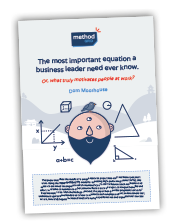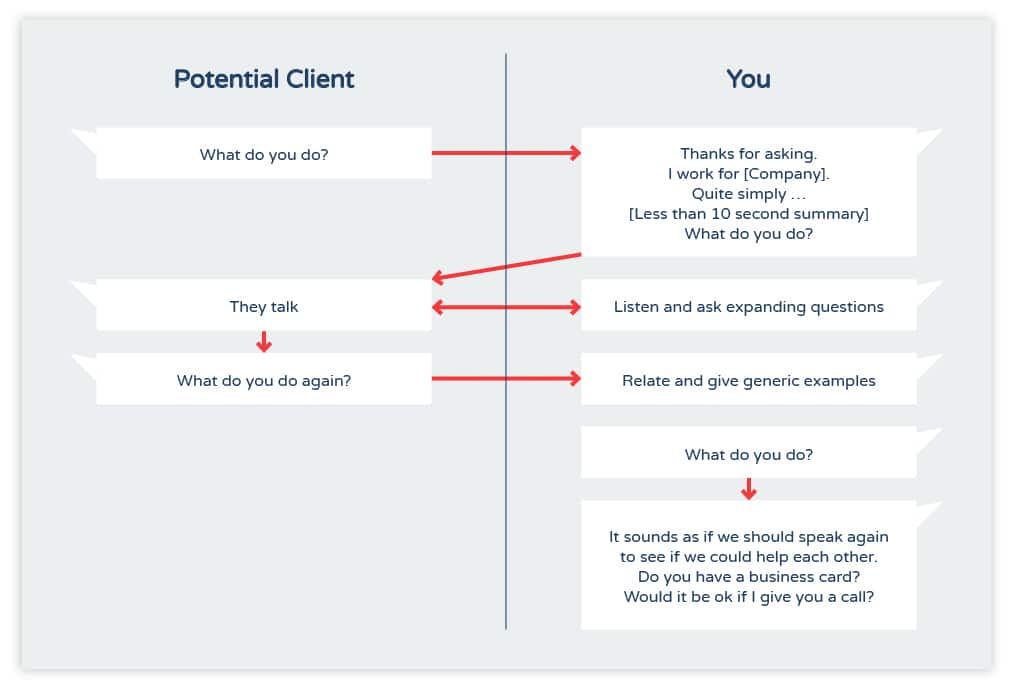What do you do? - Quite simply - Collecting a child from the community hall - Throw it back - I hate losing - I love winning - The most interesting people are those most interested in you - Flip It - Restaurant verandahs
Thus far, in previous blogs, we have explored some of the essential mechanics of a sales process and capability within a professional service context. What I want to turn to next is the fundamental elements of interaction and activity that progress contacts along the people pipeline and opportunities through to contracts. We are going to start with the proverbial elevator pitch: the catch all phrase for the myriad of everyday, real-world encounters that have the potential to morph into golden sales moments. Before we get going with this, an activity.
ACTIVITY
What do you do?
I want you to write down what it is that your firm does. Simple as that, but take your time.
How hard did you find that? Perhaps the words came easily as you have given this prior thought, or perhaps you found yourself tripping over what exact words to use. Worst of all, perhaps you filled out multiple pages.
This is crucial stuff. You have to be able to succinctly and memorably articulate what it is that you do. The more differentiated your offering, clearly, the crisper this is; for example: “Quite simply, we support our clients – major food retailers – in the running of social-media-based marketing campaigns.” At the firm I founded, Moorhouse, I would say – when asked – “Quite simply, we support organisations who are undertaking complex, scaled transformation programmes.”
Now, with my advisory work, I might say: “Quite simply, I support the owners and boards of professional service firms who are targeting value growth and an option to sell.”
You get the point. As a sales dialogue unfolds, beyond any elevator pitch, you will strip away the layers of this as required to build the solution the prospect seeks but you will not be afforded the privilege of this dialogue if – initially – you can’t keep this message short and sharp.
The Elevator Pitch: Rising to the Top
The previous section is extremely relevant in the context of the (often casual) first encounter with a potential prospect. First off, you need to be aware of how often these elevator pitch type situations come about. There are a myriad of places where you could potentially meet your next key client – be it at a professional seminar, training course, conference event or just out socially.
Certainly, if the event is one that deliberately brings together professionally relevant prospects then you should enter it with a very clear goal; for example: I am going to leave here with five permissions for a follow-up call.
In such a scenario, get into a proactive mindset. This doesn’t mean you need to turn into a superficial networker; such people stand out noticeably. This is about genuinely wanting to meet people and find out what they do as opposed to spending the whole day in the safe comfort of a conversation with work colleagues.
Please send me
The most important equation a business leader need ever know
Or, what truly motivates people at work?

Outside of such specific situations, it is about just being alive to the opportunity. Again, this isn’t about turning into an unctuous used-car salesperson. You are nowhere near selling at this stage; you are just seeking to set up – when relevant – a conversation to determine whether there is any mutual gain in you working together.
So, let’s paint a scenario. Let’s step out of the elevator pitch backdrop because, in truth, they rarely happen there! Rather, you are stood in the local community hall waiting to collect your child from a birthday party and you get chatting to one of the other parents. After the small talk, she says: “What is it that you do?”.
You now have your answer to this. Not a rambling speech but the following:
“Thank you for asking.
I work for [name of company].
Quite simply, [your short summary].”
Your tone is relaxed as if to say: it is all no big deal. The reality is – at this stage – most people are not really that interested in what you do; they are just stepping through the typical choreography of a social interaction. But here’s the key – once crisply answered – throw it straight back with a polite: “And what is it that you do?”.
This is then the time to really listen. If they reveal a career position that is of potential relevance to your services, then really engage them in conversation and further exploratory questions on this. People, in the vast majority, like talking about themselves and feeling genuinely listened to. Again, if this affirms their relevance as a potential prospect (or potential link to such a prospect in their organisation) then you will want eventually to bring the exchange to a close along the following lines:
“That’s very interesting. We have actually done a lot of successful work in the area that you mention at firms such as A, B and C [your most relevant references]. It sounds like we should set up a chat over a coffee to see if we can help each other.”
Important here – remembering the blog on effective communication – is how you say this. It is delivered almost with an air of agreed conclusion; as opposed to a “would you mind awfully, if I came and saw you at some point?” demeanour. This is about confidence in what you do, a dialogue between professional equals to explore whether a client requirement matches a professional offering.

Figure: Illustrative Elevator Pitch template
Delivered in this way, assuming there was indeed a relevant professional overlap, you will almost certainly derive a positive response from this; a “That’s a good idea; have you got a business card?” type response.
From that point on, the real Top Tip is just to bid your farewell and not get caught in further, trivial discussion (at risk of boring them) unless to actually schedule the meeting there and then. Simply exchange details, ascertain a good time to call them and say farewell.
Oh, and don’t forget to pick up your child!
This type of encounter is a really nice way to enter a sales dialogue. It makes the follow-up call effortless, indeed enjoyable.
TOP TIPS
A good motivational technique is to set not a single target but a range of target levels. In the scenario of going to a professional event and knowing you really should come away with a number of permissions-to-meet, you might set the following:
PRIDE – 2 meetings. Pride still intact if you achieve but an I hate losing motivation seeks for you to be above this level.
REALISTIC – 4 meetings. You know this is eminently achievable if you put your mind to it.
HIGH – 6 meetings. A stretch target but an I enjoy winning motivation pulls you towards it.

 Project and Program Management
Project and Program Management  Project Governance Framework
Project Governance Framework  Benefits Management Framework
Benefits Management Framework 






